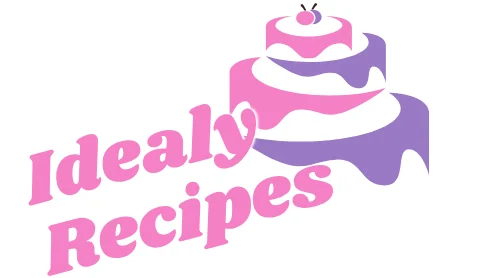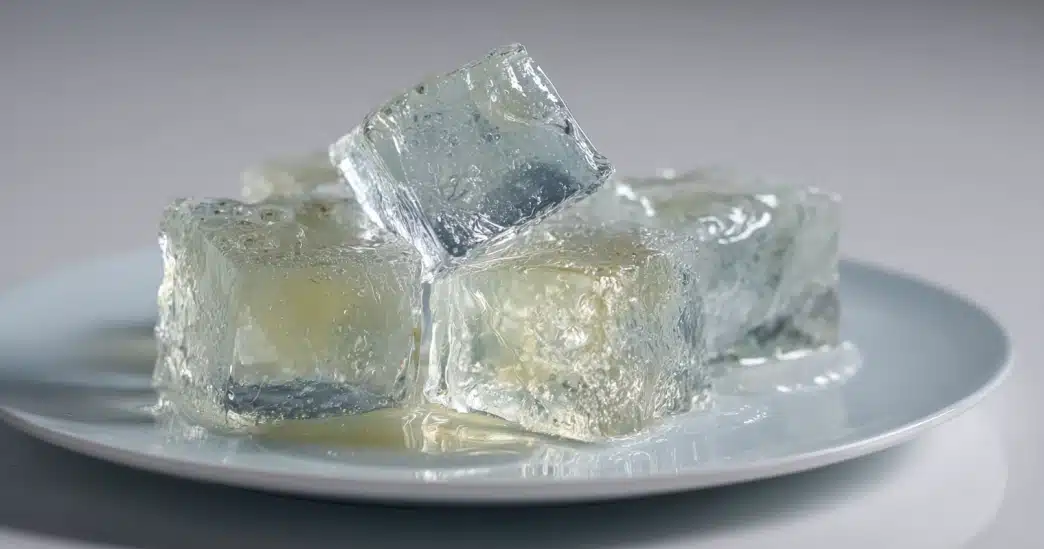Making a clear gelatin recipe sounds easy until it turns cloudy, rubbery, or oddly textured. The secret to perfect gelatin isn’t luck, it’s understanding how each small step affects clarity and structure. This guide walks you through the science and the technique so you can create transparent, flawless gelatin every time. Whether you are preparing a mirror glaze, an elegant layered dessert, or an edible art project, this method helps you achieve professional, crystal-clear results without frustration. By the end, you will know exactly how to choose your ingredients, control the temperature, and prevent the common mistakes that make gelatin cloudy or streaked.
Table of Contents
Understanding Clear Gelatin
What Is Clear Gelatin and How It Works
Clear gelatin is a colorless, flavorless gelling agent made from collagen, a protein found in animal connective tissue. When mixed with water, the gelatin molecules absorb liquid and form a smooth, elastic network. This structure is what gives gelatin its signature jiggle while keeping it firm enough to hold shapes. The key to clarity lies in controlling how the gelatin hydrates and dissolves. When the mixture is handled gently and never overheated, the protein chains align evenly, creating a see-through result that looks glassy and pure.
Clear Gelatin vs Flavored Gelatin
The difference between clear gelatin and flavored gelatin is more than just taste. Flavored products like Jell-O contain sugar, colors, and artificial ingredients that naturally make the gel cloudy. Clear gelatin, on the other hand, contains nothing but pure gelatin and water. Because it is neutral in taste and color, it can take on other flavors, colors, and designs without losing its clarity. This is why professional bakers and dessert artists rely on unflavored gelatin for mirror glazes, jelly cakes, and edible crafts. If you want a base that looks clean and elegant, start with unflavored gelatin powder or sheets.
Is Knox Unflavored Gelatin Clear
Knox is one of the most popular brands of unflavored gelatin in the United States. When prepared correctly, it yields a nearly transparent gel that looks professional and refined. The trick is to dissolve it slowly over low heat, strain the liquid, and let it cool naturally. If you see bubbles or foam, it usually means the gelatin was stirred too vigorously or overheated. Using filtered or distilled water also improves clarity since tap water can contain minerals that cloud the gel. In short, Knox gelatin can deliver beautifully clear results, but precision and patience make all the difference.
Print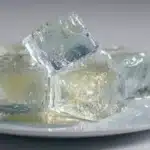
Clear Gelatin Recipe: The Best Method for Crystal Clear Results
- Total Time: 15 minutes
- Yield: 4 servings 1x
- Diet: Low Calorie
Description
Learn how to perfect a clear gelatin recipe for stunning desserts, glossy mirror glazes, and creative edible crafts. Follow this step-by-step guide for a reliable method and expert clarity tips that prevent cloudy or rubbery results.
Ingredients
2 tablespoons unflavored gelatin powder (e.g. Knox)
2 cups cold water, divided
1 teaspoon lemon juice or white vinegar (optional)
Instructions
1. In a medium bowl, sprinkle the gelatin powder evenly over 1 cup of cold water. Let it bloom undisturbed for 5–10 minutes.
2. Pour the bloomed gelatin into a saucepan. Add the remaining 1 cup water.
3. Turn heat to low and stir gently. Do not boil. Heat just until gelatin dissolves completely (120–130°F / 50–55°C).
4. Optional: Stir in lemon juice or vinegar to improve clarity.
5. Strain the mixture through a fine mesh sieve or cheesecloth into a clean bowl.
6. Let the mixture sit 2–3 minutes to allow foam to rise, then skim off the foam.
7. Pour into molds or containers and refrigerate for at least 4 hours or until set.
Notes
For clearest results, use filtered or distilled water, avoid boiling, and strain the mixture twice. Avoid stirring too vigorously to prevent air bubbles.
- Prep Time: 10 minutes
- Cook Time: 5 minutes
- Category: Dessert
- Method: Chill
- Cuisine: Universal
Nutrition
- Serving Size: 1 portion
- Calories: 30
- Sugar: 0g
- Sodium: 15mg
- Fat: 0g
- Saturated Fat: 0g
- Unsaturated Fat: 0g
- Trans Fat: 0g
- Carbohydrates: 0g
- Fiber: 0g
- Protein: 7g
- Cholesterol: 0mg
The Perfect Basic Clear Gelatin Recipe
Ingredients and Tools You Need
Making a perfect clear gelatin recipe starts with simple, precise ingredients and the right equipment. You do not need anything fancy, just clean, neutral materials that will not affect clarity.
Ingredients
- 2 tablespoons unflavored gelatin powder (Knox or similar)
- 2 cups cold water, divided
- 1 teaspoon lemon juice or white vinegar (optional for brightness)
Tools - Medium mixing bowl
- Saucepan
- Fine mesh sieve or cheesecloth
- Silicone molds or glass containers
- Thermometer (optional but helpful)
Every ingredient and tool serves a purpose. The cold water is used for blooming, which lets the gelatin hydrate evenly. The sieve removes impurities and foam that can cloud the final product. The acid, though optional, helps break down protein strands evenly, resulting in a cleaner, clearer set.
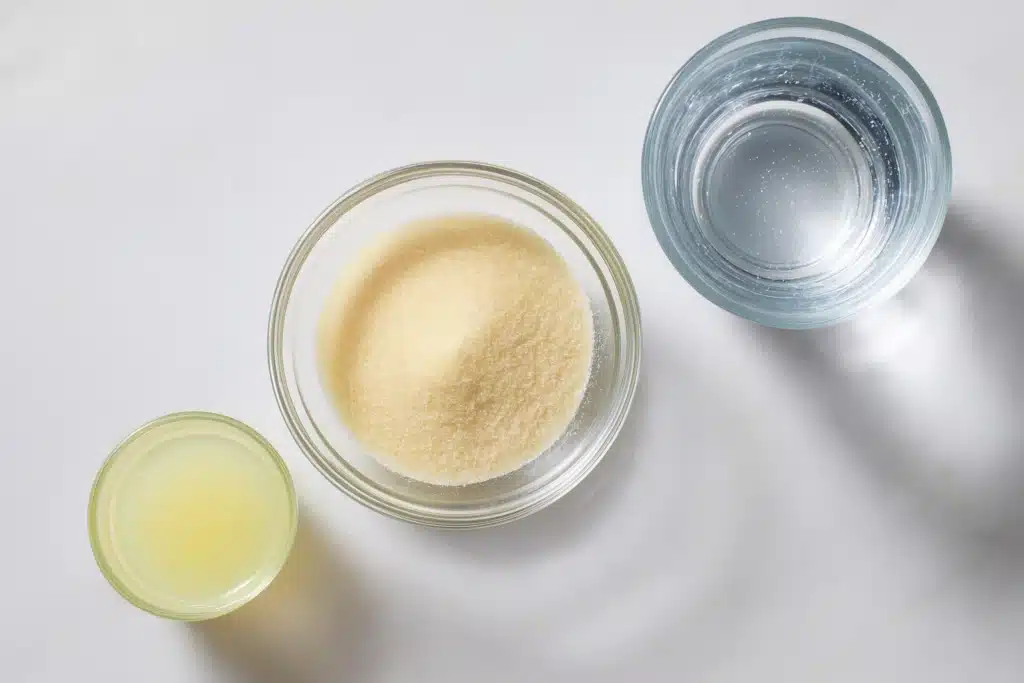
Step-by-Step Instructions
- Bloom the gelatin. Sprinkle the gelatin powder evenly over 1 cup of cold water. Let it sit for 5 to 10 minutes. This blooming step is essential because it allows the granules to absorb water and swell. If you skip this step, your gelatin will be lumpy or uneven.
- Heat gently. Pour the bloomed gelatin into a saucepan and add the remaining cup of water. Heat over low heat, stirring gently until the gelatin fully dissolves. The ideal temperature range is between 120°F and 130°F (50°C to 55°C). Do not boil, as high heat causes cloudiness.
- Optional clarity boost. Add a teaspoon of lemon juice or vinegar if you want a slightly brighter appearance. The mild acidity helps proteins dissolve more uniformly.
- Strain the mixture. Pour the liquid through a fine mesh sieve or cheesecloth into a clean bowl. This step removes undissolved particles and any foam that may have formed.
- Let it rest and set. After straining, let the mixture sit for a couple of minutes to allow any surface bubbles to rise. Skim them off carefully, then pour the gelatin into molds or containers. Chill for at least four hours until it sets completely.
Why Each Step Matters
Every part of this process affects how clear your gelatin turns out. Blooming evenly ensures no dry clumps form, while gentle heating prevents the protein molecules from breaking down. Straining removes tiny undissolved bits that can cause murkiness. Resting before chilling allows trapped air to escape, keeping the surface smooth and glassy. Each of these small habits adds up to a professional result that looks clean, firm, and transparent.
This basic clear gelatin recipe is your foundation for endless creativity. It can be adapted into mirror glazes, layered fruit gels, or even artistic jelly sculptures. The technique remains the same whether you use gelatin powder or sheets: work slowly, keep the temperature low, and always filter before chilling.
Variations and Special Methods for Clear Gelatin
How to Make Clear Gelatin for Cakes
Using clear gelatin in cakes is one of the best ways to create stunning layered desserts or glossy mirror glazes. When making clear gelatin for cakes, stability and texture are key. A cake layer needs a slightly firmer set so it holds its shape under frosting or fruit.
To achieve this, increase your gelatin ratio slightly. Use one extra teaspoon of gelatin per cup of liquid to give it more structure. Allow the gelatin to cool until it reaches a syrupy consistency before pouring it over cake layers. This helps prevent the gelatin from sinking into the sponge or sliding off the surface. Pour slowly and evenly to reduce air bubbles, and chill immediately for a flawless, glassy finish.
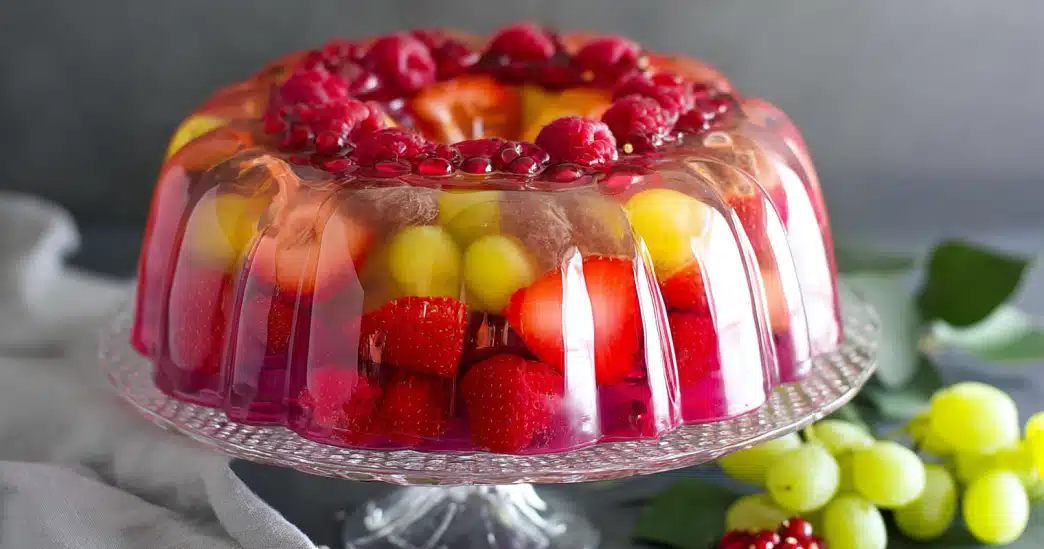
Using Knox Gelatin Powder for Best Results
Knox gelatin remains the go-to choice in most American kitchens because it is reliable, neutral, and easy to find. To use it properly, bloom one packet of Knox (about one tablespoon) in half a cup of cold water. Let it sit for at least five minutes before heating it gently with another half cup of water. Stir until completely dissolved but never boil.
If the gelatin turns cloudy, try straining it twice using cheesecloth. Another simple trick is to use distilled water instead of tap water since minerals in tap water can react with the gelatin and reduce clarity. With proper technique, Knox gelatin delivers professional results every time.
Making Clear Gelatin with Gelatin Sheets
If you want the smoothest, most refined finish, gelatin sheets are your best option. Professional pastry chefs often prefer sheets because they dissolve more evenly and produce fewer bubbles.
To substitute sheets for powder, remember that one sheet equals about half a teaspoon of powdered gelatin. Soak the sheets in cold water until soft, then squeeze gently to remove excess water. Melt the softened sheets directly into your warm liquid and stir until fully dissolved. The result is a crystal-clear gel that is perfect for mirror glazes, fruit inserts, or gelatin art.
Creating Natural Gelatin from Bones
Homemade gelatin made from bones, often called bone broth gelatin, has a rich, natural flavor and is full of nutrients. However, it is rarely as clear as store-bought gelatin. To make it as transparent as possible, start with young bones like chicken wings or beef knuckles. Simmer gently for several hours but never let it boil. Skim the surface regularly to remove foam and impurities. After straining, chill the broth until it gels, then clarify it by reheating slightly and filtering through a fine cloth. The result will have a warm, golden hue that works beautifully for rustic desserts or savory dishes.
Clear Gelatin for Crafts
Clear gelatin isn’t just for food. It can also be used in creative craft projects. Artists and hobbyists use it for making fake ice cubes, transparent display gels, and even flexible molds for stop-motion figures.
For crafting purposes, add a small amount of glycerin to keep the gelatin flexible and prevent cracking as it dries. This variation should not be eaten but is perfect for decorative work. If you’re experimenting with edible crafts, like jelly terrariums or gummy decorations, stick to food-safe recipes and molds.
Expert Tips for Crystal-Clear Gelatin
Avoiding Common Clarity Mistakes
Even when you follow a clear gelatin recipe carefully, small missteps can spoil the result. Overheating is a major culprit; it causes proteins to denature unevenly, creating haze or bubbles. Always heat slowly and keep below 130°F (55°C). Stirring too vigorously also traps air, leading to foam or cloudiness. Use a gentle folding motion instead of aggressive agitation.
Temperature Control Secrets
Temperature is the foundation of clarity. Gelatin needs enough heat to fully dissolve, but if it gets too hot you lose transparency. Use a thermometer if possible to maintain between 120°F and 130°F. If you don’t have one, look for a silky, steam-free surface and remove from heat as soon as the gel appears uniform. Let it rest briefly before straining so any bubbles can escape.
The Role of Acids and Filtration
Acidic additives like lemon juice or white vinegar can help gelatin appear brighter and clearer. Use about ½ to 1 teaspoon per cup of liquid—but go easy, since too much acid interferes with setting. Filtration is equally important. Strain the mixture through a fine mesh sieve or multiple layers of cheesecloth to remove undissolved bits and foam. For best results, strain twice.
Blooming and Resting Techniques
Blooming means hydrating gelatin in cold water before heating it. If you skip or rush this step, you risk uneven expansion and opacity. Sprinkle the gelatin evenly over cold water and let it sit for 5 to 10 minutes. After dissolving, allow a short rest so trapped bubbles rise and can be skimmed off. This quiet pause often makes the difference between a glassy surface and a dull one.
For further reading on gelatin science, you can refer to “6 Unexpected Factors That Can Ruin Your Gelatin Desserts” on Serious Eats which explains how heat, bloom strength, acidity, and sugar all influence your results. Serious Eats
Troubleshooting Clear Gelatin
Why Is My Gelatin Cloudy
Cloudy gelatin happens for a few predictable reasons, and most can be easily fixed. The most common cause is overheating, which causes the gelatin proteins to break down unevenly. This leads to bubbles and a foggy texture. Another reason is unfiltered water that contains minerals or impurities. Always use filtered or distilled water for the best results. Stirring too quickly can also trap air, creating foam that stays suspended in the mixture. Finally, if the gelatin was not strained, small undissolved particles can float in the gel, reducing its clarity. To fix this, strain the liquid through a cheesecloth and let it rest before chilling so bubbles can rise and burst.
Why Gelatin Didn’t Set Properly
If your gelatin turns out too soft or watery, the problem is usually the ratio or temperature. Not enough gelatin powder or too much liquid results in a loose texture that won’t hold its shape. For standard clarity and firmness, use one tablespoon of gelatin for every cup of liquid. Overheating can also weaken the gelatin structure and make it unstable. Always heat gently, only until the gelatin dissolves completely. If your gelatin never set, you can remelt it by warming it slowly and adding a small amount of additional gelatin powder, then refrigerate again.
How to Fix Overheated or Foamy Gelatin
When gelatin is accidentally boiled or stirred too hard, it often turns opaque or forms a foamy surface. To repair it, let the mixture cool slightly, then skim the foam off gently with a spoon. Next, strain the mixture through a fine cloth or coffee filter to remove any protein residue. This won’t make it perfectly clear again, but it will significantly improve appearance. If it becomes rubbery after overheating, you can salvage it by melting it again with a small amount of warm water and resetting it in a new mold.
Common Myths About Clear Gelatin
Many people believe that sugar, flavoring, or fruit juice automatically make gelatin cloudy. While these ingredients do affect clarity, it depends on timing and technique. You can still create semi-clear layers by allowing the clear gelatin to set first before adding flavored or colored layers. Another myth is that all clear gelatins are flavorless. While unflavored gelatin starts neutral, you can infuse subtle flavor with clear extracts like vanilla or citrus essence without changing its appearance. Some also think gelatin can’t be reheated once set, but it can, as long as you keep the temperature low and avoid boiling.
Troubleshooting gelatin takes patience and practice. Once you understand why clarity problems happen, every batch becomes easier to perfect. Small details like water purity, temperature control, and gentle handling make the biggest difference.
Creative Uses for Clear Gelatin
Dessert Applications
Clear gelatin is an incredibly versatile ingredient for desserts. It can be used to create mirror glaze cakes, layered jelly desserts, or fruit suspensions that seem to float inside the gel. For fruit suspensions, pour the gelatin when it has cooled to a syrupy consistency. Add small fruit pieces or edible flowers and let them settle naturally before chilling. This creates an elegant, crystal-clear effect that looks professional. Layered gelatin desserts are another favorite use. Alternate clear and flavored layers to create colorful patterns with perfect transparency in between. For mirror glazes, use a slightly softer set by reducing the gelatin ratio so the surface remains smooth and reflective.
Cakes and Edible Art
Clear gelatin is a favorite among pastry chefs for edible art and cake decorations. It allows bakers to create jelly toppers, encapsulated fruit decorations, or 3D flower designs that add a stunning visual touch to desserts. To make a clear cake topper, pour the gelatin into a shallow silicone mold and chill until firm. Once set, it can be cut or shaped as desired. For 3D gelatin art, use clear gelatin as the base and inject food coloring or milk-based mixtures to form floral patterns. These techniques transform a simple gelatin base into a beautiful centerpiece.
Semi-Clear Gelatin with Milk or Juices
If you prefer a frosted look rather than complete transparency, mix gelatin with milk or light juices. This creates a semi-clear or pastel effect that looks soft and creamy. The key is to bloom the gelatin separately in water before adding it to the warm milk or juice. Avoid boiling any dairy mixture to prevent curdling. This technique is perfect for panna cotta-style desserts or cloudy sky effects in artistic gelatin projects.
Craft and Display Projects
Clear gelatin is also a fun material for non-edible projects. It is used in model-making, artistic displays, and educational crafts. For instance, it can mimic frozen ice or clear water in decorative settings. Adding a few drops of glycerin helps the gelatin remain flexible and prevents cracking as it dries. Some artists use gelatin to create botanical jewelry molds or stop-motion animation figures. When using it for non-edible purposes, always label your creations clearly to avoid confusion.
Clear gelatin is not limited to the kitchen. Its adaptability and visual appeal make it a great medium for anyone who enjoys combining art with science. Whether you are baking or crafting, this simple ingredient offers endless creative possibilities.
Storing and Handling Clear Gelatin
How to Store Gelatin for Maximum Freshness
Once your clear gelatin recipe is perfectly set, storing it the right way helps maintain its shine and texture. Always keep it refrigerated in an airtight container. Exposure to air can dry the surface and create a rubbery film. Cover the gelatin with plastic wrap pressed lightly against the surface to prevent condensation from forming. Properly stored, clear gelatin stays fresh for up to seven days. If you are using it as a cake topper or decorative layer, prepare it a day in advance for the best presentation.
Avoiding Contamination and Odor Absorption
Clear gelatin is like a sponge for odors. It easily absorbs smells from other foods in the refrigerator. Always keep your clear gelatin recipe away from strong-scented items such as onions or seafood. Storing it in a sealed glass or plastic container keeps it odor-free and tasting neutral. If your gelatin starts to develop an off smell or discoloration, it means it’s past its prime and should be discarded. Clean molds and utensils thoroughly before each use since even a trace of oil or detergent can affect the texture or clarity.
Freezing Gelatin: Good or Bad Idea
Freezing your clear gelatin recipe may sound convenient, but it actually ruins its texture. When gelatin freezes, the water inside expands and breaks the gel structure. Once thawed, it turns watery and uneven. Instead of freezing, prepare smaller batches more often. If you need to store it longer, keep it refrigerated and well-covered. For decorative projects, you can make a fresh batch using the same gelatin base, ensuring it retains its crystal-clear appearance and firm texture.
Proper storage is essential for keeping your clear gelatin recipe pristine and ready for use. Treat it gently, protect it from odors, and avoid freezing, and you’ll have consistently perfect gelatin for desserts or crafts.
Conclusion and Final Thoughts
Mastering a clear gelatin recipe takes patience, precision, and an understanding of how gelatin behaves. Every step, from blooming to straining, affects clarity. When you bloom the gelatin properly, heat it gently, and allow bubbles to settle before chilling, the result is a crystal-clear base that looks and tastes professional.
The beauty of a clear gelatin recipe is its versatility. It can be transformed into elegant desserts, used in layered creations, or shaped into edible art. With a little practice, you can use this same base to make mirror glazes, fruit suspensions, or even craft projects that shine like glass.
Remember to store your gelatin carefully, always refrigerating it in an airtight container to preserve its smooth texture. Avoid freezing it to keep the surface pristine. Whether you are experimenting with Knox gelatin, gelatin sheets, or bone-based recipes, the same principles apply. Work slowly, handle gently, and you’ll always end up with perfect clarity.
If this guide helped you understand how to create a flawless clear gelatin recipe, share it with other food enthusiasts or comment below with your favorite gelatin projects. Your experience can help others avoid cloudy, rubbery results and enjoy stunning desserts every time.
FAQs About Clear Gelatin Recipe
How do you make clear gelatin?
To make a perfect clear gelatin recipe, start by blooming unflavored gelatin in cold water for about 10 minutes. Then warm it gently over low heat until completely dissolved. Strain the mixture through a fine mesh sieve and let it rest before chilling. Use filtered or distilled water and avoid boiling to maintain crystal clarity. This method ensures your clear gelatin base stays transparent and smooth.
What is clear gelatin made of?
Clear gelatin is made from collagen, a natural protein extracted from animal bones and connective tissues. It is processed into a fine powder or thin sheets that dissolve in water to create a gel. Because the basic clear gelatin recipe contains no color, sugar, or additives, it remains flavorless and ideal for both sweet and savory dishes.
Is Knox unflavored gelatin clear?
Yes, Knox unflavored gelatin creates a nearly transparent result when handled properly. When using Knox in your clear gelatin recipe, make sure to dissolve it slowly, strain carefully, and refrigerate without stirring once poured into molds. Proper handling keeps it glossy and clear, making it perfect for desserts and mirror glazes.
How to make gelatin crystal clear?
If your goal is to make gelatin as clear as glass, always start with distilled water and fresh gelatin. Gently heat the mixture without boiling, strain twice through cheesecloth, and let it rest before chilling. Adding a few drops of lemon juice can help proteins break down evenly, producing a polished and bright finish. Follow these same rules each time you make a clear gelatin recipe to guarantee consistent results.
Clear gelatin recipe for cake, any special tweaks?
When using a clear gelatin recipe for cake decorations or fruit layers, add one extra teaspoon of gelatin per cup of liquid for a stronger set. Allow the gelatin to thicken slightly before pouring it over the cake to prevent it from sliding or seeping into the sponge. This method gives your cake layers a stable, shiny appearance that holds perfectly during serving.
How to make gelatin from bones, is that as clear?
Homemade gelatin from bones, also known as bone broth gelatin, is nutritious but not always as clear as a powdered clear gelatin recipe. To make it as transparent as possible, simmer bones slowly and skim impurities from the surface. Strain carefully, chill, and clarify through fine filtration. You will get a natural golden hue that’s great for rustic dishes or savory jellies.
These questions cover the most common challenges faced by anyone making a clear gelatin recipe. Following these best practices ensures your gelatin looks elegant, sets perfectly, and stays consistently clear every time.
